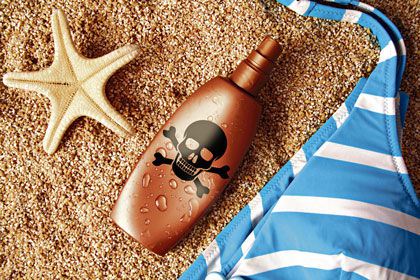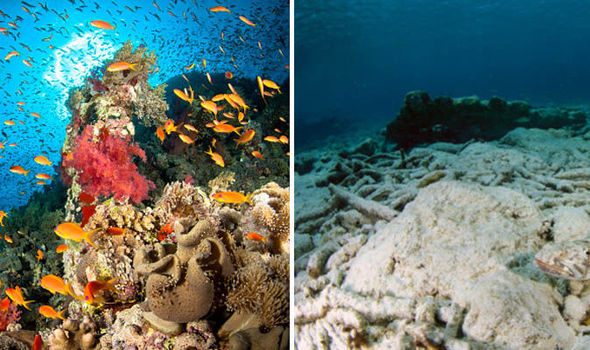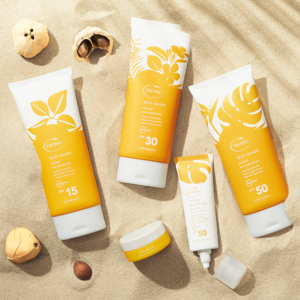
As you are probably aware, I am a Tropic Skincare Ambassador. You’d be forgiven for thinking that I’m biased when it comes to the choice between natural, cruelty-free skincare options and those more often found on the supermarket shelves. Let me share with you some of the reasons why I am so passionately advocating a switch from your old usual sunscreen to a healthier alternative.
Sunscreen protects our skin, right? It blocks harmful UVA and UVB light preventing sunburn, skin damage, skin aging and cancer. Those things are true, but depending on what type of sunscreen you are using, it could be doing a whole lot of other damage – to your body and to the environment.
The vast majority of sunscreens on the market are chemical sunscreens. This is because they are cheaper and easier to formulate and soak into the skin easily. They work by coating the skin in a chemical that reacts to UV rays. However, once it has reacted, this chemical is now spent and you will need to reapply. And you also now have a chemical reaction occurring on your skin which causes the formation of free radicals – a major cause of skin aging and skin damage. So let’s get this straight – we are using sunscreen to prevent skin aging and skin damage, but sunscreen is actually a cause of skin aging and skin damage? What’s the point in that?
What makes this even worse, is that the majority of chemical sunscreens (about 70%) contain a toxic chemical oxybenzone – around 3,500 brands worldwide. A study by the Centres of Disease Control and Prevention showed this chemical to be present in 97% of Americans (Calafat 2008). Oxybenzone is absorbed through the skin into your bloodstream, where is then acts as a hormone disruptor. It is also found to be present in breastmilk and urine. The good news is that researchers at UC Berkeley discovered that oxybenzone levels and those of other chemicals of concern reduced dramatically when an alternative chemical-free sunscreen was used instead (Harley 2016). Experts caution that the unintentional exposure to and toxicity of active ingredients erode the benefits of sunscreens (Krause 2012, Schlumpf 2010).
Researchers from Denmark and Sweden investigated the hormone disruption caused by the chemical UV filters oxybenzone, homosalate, octinoxate, Benzophenone-2, PABA, OD-PABA, 3-BC and 4-MBC (Krause 2012). They reported that these chemicals affect reproduction and development by altering reproductive and thyroid hormones.
As if it wasn’t bad enough that a product we use to protect ourselves is actually causing untold damage – chemical sunscreens are responsible for enormous damage to the environment. They are putting our oceans and marine life, in particular, at risk. According to the Archives of Environmental Contamination and Toxicology, between 6,000 and 14,000 tonnes of sunscreen ends up in coral reef areas each year from swimmers, scuba divers, and snorkelers. Chemical sunscreen has been found to be killing off coral, especially around tourist areas. The Caribbean, Hawaii and the Great Barrier Reef have been dramatically affected. Similar to how it is damaging to human health, oxybenzone alters coral DNA, makes coral more susceptible to potentially fatal bleaching and acts as an endocrine disruptor, causing baby coral to encase itself in its own skeleton and die, according to the findings of the Haereticus Environmental Laboratory in Virginia. Nor does it take much of this chemical to do damage – the damaging effects were seen in coral in concentrations of oxybenzone as low as 62 parts per trillion, which is equivalent to a drop of water in six and a half Olympic-sized swimming pools.
So, what are the alternatives? Do we have to burn our skin to save the environment? Thankfully, there is a healthier, environmentally friendly alternative and that is mineral sunscreen. The active ingredients are zinc oxide and titanium dioxide. Mineral sunscreens work by forming a barrier on the skin. They reflect the UV rays back into the atmosphere and remain completely inert on the skin. It is n0t absorbed by the skin. Mineral protection isn’t used commonly by sunscreen manufacturers as these ingredients are very difficult to formulate with and often leave a white sheen after application. But Susan Ma at Tropic Skincare has been working for the past couple of years to design a range of natural, vegan, cruelty-free sun care. And boy, has she done a great job.
Last year Tropic introduced its first mineral sunscreen in SPF 30, and such was its popularity one of the ingredient suppliers couldn’t keep up with demand and we had to discontinue until we found a new supplier. In this time, Susan has not only improved the formulation and removed essential oils to make it suitable for even the most sensitive of skins, but come up with three entirely new formulations: SPF 15, 30 and 50. The first two are oil-in-water lotions which are very light in texture and blend into the skin within seconds, while the SPF 50 is a thicker water-in-oil cream which still blends in perfectly leaving no white streaks. They have been tested against all other sunscreen hands on the market and has beaten them all hands down. They offer the highest protection levels and water resistance, are kind to your skin and to the environment. Good job Susie!
Alongside the 3 standard sunscreens Tropic have also introduced an SPF 50 Sun Balm, an oil-based balm to add extra protection to those particularly burn-prone spots and is great for all over use on babies and small children. And we have the Tinted Sun Shade which is a 3-in-one moisturiser, BB cream and sunscreen. It is really water resistant so your make up doesn’t wash off in the water.
I hope that after reading this you feel inspired to rethink your sunscreen choices this summer. While natural, ethical mineral sunscreens are more expensive, they offer better protection, you don’t need to constantly reapply and I feel that knowing what I now know, I can’t in all good conscience continue to pollute my body and the oceans.
For more information on Tropic Skincare and to take a look at our range visit my Tropic shop


